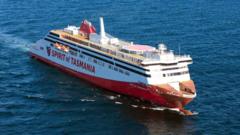The vessel, 212 meters (695 feet) long, will temporarily be stored at the Port of Leith in Scotland as it encounters delays stemming from construction setbacks and infrastructure inadequacies back in Tasmania. Originally constructed in Finland, the ferry's relocation comes as officials fear it may suffer damage from impending pack ice, necessitating a move before the winter chill sets in. A new berth in Tasmania is delayed until at least late 2026 or 2027, further complicating matters for the state-owned TT-Line ferry company and its infrastructure partner TasPorts.
This situation has escalated into what is being referred to as a "ferries fiasco," drawing widespread criticism and political controversy in Australia. Local media highlighted the debacle, with opposition leader Dean Winter denouncing it as the most significant infrastructure mismanagement in recent years. In light of these failures, both the infrastructure minister and TT-Line's chairman have resigned amidst mounting pressure.
The chief executive of TT-Line, Bernard Dwyer, elaborated on the timing and reason for the move, stating, "To ensure the vessel’s safety and preservation, we will temporarily relocate it to Leith, Scotland, where conditions are more suitable. This move is necessary, as the vessel is not designed for the extremely low ambient temperatures anticipated in Rauma."
There’s also speculation about the potential leasing of the ship, but further modifications are needed due to the original agreement mandating remaining work to be completed in Tasmania. Unfortunately, it appears unlikely that these vessels will find a new purpose in Scotland's ferries, despite local operators like CalMac being in urgent need of new ships.
The unfolding narrative echoes a similar situation in Scotland, where CMAL ordered oversized vessels struggling to dock at existing ports, resulting in their own local "ferries fiasco." The Glen Sannox and Glen Rosa ships are delayed due to unresolved redevelopment plans, leaving both operators and travelers grappling with prolonged journey times and logistical complications. As both nations wrestle with ferry-related challenges, the focus remains on finding sustainable solutions to enhance maritime infrastructure and services.
This situation has escalated into what is being referred to as a "ferries fiasco," drawing widespread criticism and political controversy in Australia. Local media highlighted the debacle, with opposition leader Dean Winter denouncing it as the most significant infrastructure mismanagement in recent years. In light of these failures, both the infrastructure minister and TT-Line's chairman have resigned amidst mounting pressure.
The chief executive of TT-Line, Bernard Dwyer, elaborated on the timing and reason for the move, stating, "To ensure the vessel’s safety and preservation, we will temporarily relocate it to Leith, Scotland, where conditions are more suitable. This move is necessary, as the vessel is not designed for the extremely low ambient temperatures anticipated in Rauma."
There’s also speculation about the potential leasing of the ship, but further modifications are needed due to the original agreement mandating remaining work to be completed in Tasmania. Unfortunately, it appears unlikely that these vessels will find a new purpose in Scotland's ferries, despite local operators like CalMac being in urgent need of new ships.
The unfolding narrative echoes a similar situation in Scotland, where CMAL ordered oversized vessels struggling to dock at existing ports, resulting in their own local "ferries fiasco." The Glen Sannox and Glen Rosa ships are delayed due to unresolved redevelopment plans, leaving both operators and travelers grappling with prolonged journey times and logistical complications. As both nations wrestle with ferry-related challenges, the focus remains on finding sustainable solutions to enhance maritime infrastructure and services.




















